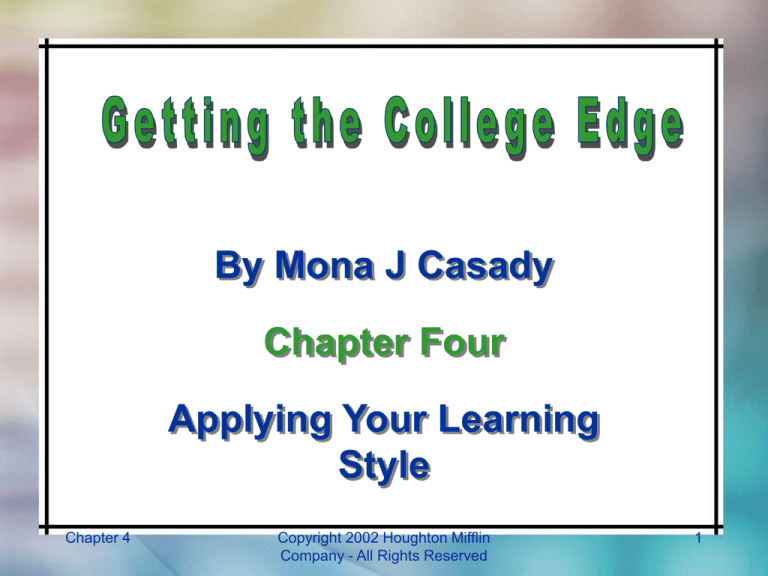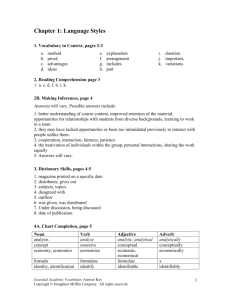
By Mona J Casady
Chapter Four
Applying Your Learning
Style
Chapter 4
Copyright 2002 Houghton Mifflin
Company - All Rights Reserved
1
This chapter should help
you to:
• Be aware of what influences your
learning style
• Identify your learning style
• Adjust to teaching styles
• Advance your thinking and learning
skills
Chapter 4
Copyright 2002 Houghton Mifflin
Company - All Rights Reserved
2
Brain Mode Influences
Left Brain Mode Influences
• Thinking and skills that are logical,
sequential, linear, rational, and verbal
Right Brain Mode Influences
• Thinking and skills that are intuitive,
random, holistic, emotional, and
nonverbal
Chapter 4
Copyright 2002 Houghton Mifflin
Company - All Rights Reserved
3
Comparing Learning
Styles
Factual - Make lists and
memorize facts
Analytical - Analyze data
and look for concepts
Chapter 4
Copyright 2002 Houghton Mifflin
Company - All Rights Reserved
4
Comparing Learning
Styles
Participative/Dependent Study with others, discuss in
class
Competitive/Independent Study alone, listen to lecture
Chapter 4
Copyright 2002 Houghton Mifflin
Company - All Rights Reserved
5
Comparing Learning
Styles
• Visual
• Auditory
• Kinesthetic
Chapter 4
Copyright 2002 Houghton Mifflin
Company - All Rights Reserved
6
Visual
• Remembers what was seen
• Takes notes; writes
information
• Understands by seeing
• Likes visual cues that are
well organized
Chapter 4
Copyright 2002 Houghton Mifflin
Company - All Rights Reserved
7
Auditory
• Remembers what was discussed
• Speaks aloud; records on tape
• Understands by hearing and
talking
• Likes music and listening to
stories
Chapter 4
Copyright 2002 Houghton Mifflin
Company - All Rights Reserved
8
Kinesthetic
•
•
•
•
Chapter 4
Remembers what was done
Practices application
Understands by doing
Likes action; points and
gestures
Copyright 2002 Houghton Mifflin
Company - All Rights Reserved
9
Adjust to Teaching Styles
What if the instructor’s style is not
compatible with your learning style?
• Learning will be more challenging than if the
instructor’s style matches your learning style
• By strengthening your less-refined learning styles,
you can adjust to the instructor’s style and excel in
the course
• Your efforts in strengthening the other learning
styles will pay off as you encounter various types of
courses and instructors throughout college
Chapter 4
Copyright 2002 Houghton Mifflin
Company - All Rights Reserved
10
Advancing Your Thinking Skills
Creative Thinking
• Discovering new and better ideas
• Using your imagination
• Brainstorming
Critical Thinking
• Facing a challenge
• Solving a problem
• Making sound decisions
Chapter 4
Copyright 2002 Houghton Mifflin
Company - All Rights Reserved
11
Memorization Techniques
• Preparing flash cards
• Vocabulary - word on one side
and definition on the other
• States and their capitals
• Questions and their answers
Chapter 4
Copyright 2002 Houghton Mifflin
Company - All Rights Reserved
12
Memorization Techniques
• Learning names - create an adjective
to match first letter of name –
(Example: Able Abby, Bright Brad)
• Using Mnemonics: (Example)
Getting an EDGE to college success:
Efficiency
Determination
Grace
Enthusiasm
Chapter 4
Copyright 2002 Houghton Mifflin
Company - All Rights Reserved
13
Decision Making
Making sound decisions
involves the use of high-level
thinking skills, consideration of
personal values, and knowledge
of self.
Chapter 4
Copyright 2002 Houghton Mifflin
Company - All Rights Reserved
14
Steps to Lifetime Learning
•
•
•
•
Desire to become smarter (First Step)
Be aware of how you learn
Strengthen all dimensions of learning.
Improve your creative thinking and critical
thinking skills
• Elevate your learning level
• Apply your intelligence in making decisions
and solving problems (Ultimate Step)
Chapter 4
Copyright 2002 Houghton Mifflin
Company - All Rights Reserved
15

